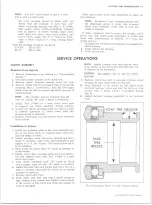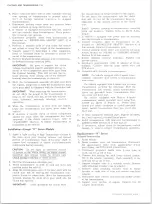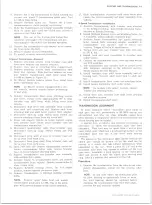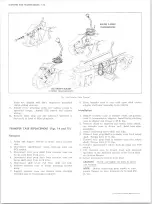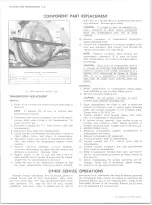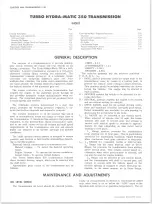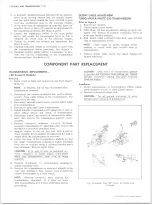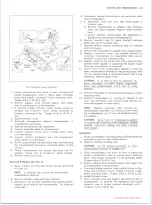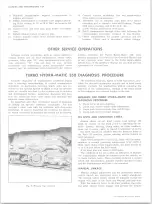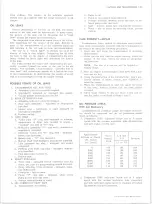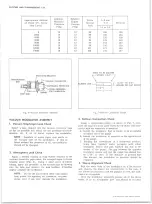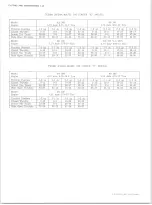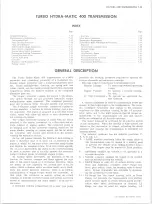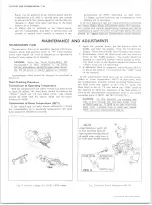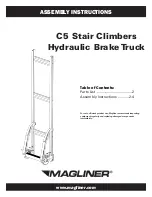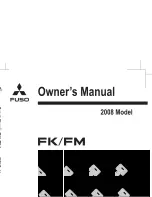
CLUTCHES AND TRANSMISSIONS 7-18
rolling. The pointer on the indicator quadrant should line
up properly with the range indicators in all ranges.
OIL LEAKS
Before attempting to correct an oil leak, the actual
source of the leak must be determined. In many cases the
source of the leak can be deceiving due to “ wind flow”
around the engine and transmission.
The suspected area should be wiped clean of all oil
before inspecting for the source of the leak. Red dye is
used in the transmission oil at the assembly plant and
will indicate if the oil leak is from the transmission.
The use of a “ black light" * to identify the oil at the
source of leak is also helpful. Comparing the oil from the
leak to that on the engine or transmission dip stick (when
viewed by “ black light" will determine the source of the
leak.
Oil leaks around the engine and transmission are
generally carried toward the rear of the car by the air
stream. For example, a transmission “ oil filter tube to
case leak" will sometimes appear as a leak at the rear
of the transmission. In determining the source of an oil
leak it is most helpful to keep the engine running.
The mating surfaces of servo cover, converter hous
ing, transmission case and transmission case extension
should be carefully examined for signs of leakage. The
vacuum modulator must also be checked to insure that
the diaphragm has not ruptured as this would allow trans
mission oil to be drawn into the intake manifold. Usually,
the exhaust will be excessively smoky if the diaphragm
ruptures due to the transmission oil added to the combus
tion. The transmission case extension rear oil seal
should also be checked. All test plugs should be checked
to make sure that they are tight and that there is no sign
of leakage at these points. The converter underpan should
also be removed. Any appreciable quantity of oil in this
area would indicate leakage at the oil pump square seal
ring, oil pump seal assembly, or oil pump bolt seating
washers.
BASIC PRESSURE CHECKS
Four basic pressure checks are used for diagnosis and
operational checks for the Aluminum Powerglide trans
mission. All checks should be made only after thoroughly
warming up the transmission.
•
Wide Open Throttle Upshift Pressure.
•
Idle Pressure in “ Drive" Range.
•
Manual “ Low" Range Pressure.
•
' ‘Drive" Range Overrun (Coast) Pressure.
It is not recommended that stall tests be conducted
which would result in engine vacuum falling below 10" Hg.
Pressure gauge hose connections should be made at the
low servo apply (main line) test point (fig. 5PG). Run the
gauge line into the driving compartment by pushing aside
the mast jacket seal. Tie line out of the way of the
drivers feet and connect to Pressure Gauge J-21867.
• Wide Open Throttle Upshift Pressure Check
Refer to the pressure check chart for upshift pressure
points as indicated on the low servo apply (main line)
gauge.
• Idle Pressure in “ Drive" Range
In addition to the oil pressure gauges, a vacuum gauge
is needed for this check.
With the parking brake applied and the shift selector
lever in “ Drive", low servo apply (main line) pressure
should be as shown on the pressure check chart.
If pressures are not within these ranges, the following
items should be checked for oil circuit leakage:
1. Pressure regulator valve stuck.
2. Vacuum modulator valve stuck.
3. Hydraulic modulator valve stuck.
4. Leak at low servo piston ring (between ring and
bore).
5. Leak at low servo piston rod (between rod and bore).
6. Leak at valve body to case gasket.
7. Leak at valve body gaskets.
8. Oil pump clearances.
9. Check passages in transmission case for porosity.
• Manual “ Low" Range Pressure Check
Connect a tachometer, apply the parking brake, place
the selector lever in “ Low" range, and adjust the engine
speed to 1000 rpm with the car stationary.
Low servo apply (main line) pressure should be as
shown on the pressure check chart.
Pressures not within this range can indicate the follow
ing possibilities:
1. Partially plugged oil suction screen.
2. Broken or damaged ring low servo.
3. Pressure regulator valve stuck.
4. Leak at valve body to case gasket.
5. Leak between valve body gaskets.
6. Leak at servo center.
7. Oil pump clearances.
• Drive Range Overrun (Coast) Pressure
With the vehicle coasting in “ Drive" range at 20-25
MPH with engine vecuum at approximately 20” Hg., low
servo apply (main line) pressure should be as shown on
the pressure check chart.
*A “ Black Light" testing unit may be obtained from several different service tool suppliers.
POWERGLIDE BASIC PRESSURE (MAINLINE) CHECKS
Engines
Wide Open
Throttle
Upshift
Idle Pressure
In Drive Range
Manual Low
Range @
1000 RPM
Drive Range Overrun
(Coast) @ 20-35 MPH
(Approx. 20” Hg.)
16" Hg.
10" Hg.
L-6 250
V-8 307
93-113
103-118
53-75
53-74
83-102
81-100
125-138
115-128
48-53
48-53
10-30 CHEVROLET TRUCK SERVICE MANUAL
Содержание 10 1971 Series
Страница 1: ......
Страница 96: ......
Страница 100: ...10 30 CHEVROLET TRUCK SERVICE MANUAL Fig 4 10 30 Series Truck Frame FRAME 2 4 ...
Страница 120: ......
Страница 203: ...ENGINE 6 25 Fig 22L Engine Mounts 10 30 CHEVROLET TRUCK SERVICE MANUAL ...
Страница 215: ...ENGINE 6 37 REAR M O U NT Fig 21V Engine Mounts 10 30 CHEVROLET TRUCK SERVICE MANUAL ...
Страница 218: ......
Страница 249: ......
Страница 250: ...EMISSION CONTROL SYSTEMS 6T 4 Fig 3 Combination Emission Control System Routing V8 10 30 CHEVROLET TRUCK SERVICE MANUAL ...
Страница 324: ......
Страница 339: ...FUEL TANK AND EXHAUST SYSTEMS 8 15 SPECIAL TOOLS Fig 22 Special Tools 1 J 23346 Fuel Tank Gauge Remover and Installer ...
Страница 340: ......
Страница 365: ...10 30 CHEVROLET TRUCK SERVICE MANUAL Fig 43 Power Steering Pump M ounting STEERING 9 25 ...
Страница 368: ......
Страница 386: ......
Страница 390: ...ELECTRICAL BODY AND CHASSIS 12 4 10 30 CHEVROLET TRUCK SERVICE MANUAL ...
Страница 391: ......
Страница 392: ...ELECTRICAL BODY AND CHASSIS 12 6 Fig 5 Rear Lighting Composite 10 30 CHEVROLET TRUCK SERVICE MANUAL ...
Страница 409: ...ELECTRICAL BODY AND CHASSIS 12 23 Fig 27 Engine Compartment CA30 02 10 30 CHEVROLET TRUCK SERVICE MANUAL ...
Страница 410: ...ELECTRICAL BODY AND CHASSIS 12 24 18DK GRN 19 Fig 28 Instrument Panel CA30 02 10 30 CHEVROLET TRUCK SERVICE MANUAL ...
Страница 411: ...ELECTRICAL BODY AND CHASSIS 12 25 Fig 29 Instrument Panel CA30 02 10 30 CHEVROLET TRUCK SERVICE MANUAL ...
Страница 412: ...ELECTRICAL BODY AND CHASSIS 12 26 fh Ar r kk 4 Fig 30 Engine Compartment C A K A 10 20 CA30 03 z _ ...
Страница 416: ...ELECTRICAL BODY AND CHASSIS 12 30 Fig 34 Engine Compartment CA KA10 20 CA30 04 10 30 CHEVROLET TRUCK SERVICE MANUAL ...
Страница 420: ...ELECTRICAL BODY AND CHASSIS 12 34 Fig 38 Engine Compartment C A K A 1 0 20 06 16 10 30 CHEVROLET TRUCK SERVICE MANUAL ...
Страница 422: ...ELECTRICAL BODY AND CHASSIS 12 36 Fig 40 Instrument Panel C A K A 10 20 06 16 10 30 CHEVROLET TRUCK SERVICE MANUAL ...
Страница 423: ...ELECTRICAL BODY AND CHASSIS 12 37 Fig 41 R ear Lamps C A K A 1 0 20 06 16 10 30 CHEVROLET TRUCK SERVICE MANUAL ...
Страница 424: ...ELECTRICAL BODY AND CHASSIS 12 38 Fig 42 Engine Compartment CA KA10 20 CAl30 14 34 10 30 CHEVROLET TRUCK SERVICE MANUAL ...
Страница 426: ...ELECTRICAL BODY AND CHASSIS 12 40 Fig 44 Instrument Panel CA KA10 20 CA30 14 34 10 30 CHEVROLET TRUCK SERVICE MANUAL ...
Страница 428: ......
Страница 432: ......
Страница 449: ...SPECIFICATIONS 9 10 30 CHEVROLET TRUCK SERVICE MANUAL ...
Страница 463: ......
Страница 464: ......
Страница 465: ......
Страница 466: ......


